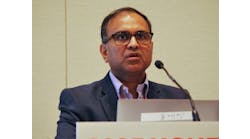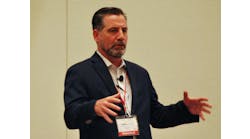"Since we're in Washington, DC," John Berra quipped, in his last official address as business leader of Emerson Process Management, "I thought I should give a state of the union address. We are stronger than we have ever been before. This is the last week of our Fiscal Year, and I can't reveal the whole year numbers, but for the first 3 quarters, our business was up 18% over last year. If the numbers stay on track, Berra intimated, Emerson may grow a little over a billion dollars in a single year.
"Orders stay ahead of sales," Berra said, "so we continue to be very optimistic for FY09."
Emerson has hired over 1200 salaried and 1500 hourly employees in the last year. "Since 2002," Berra declared, "we have averaged over 12% of revenue on Research and Development. I promise you we will do that forever."
Emerson has continued its string of strategic acquisitions, with Topworx and The Automation Group, and according to Berra, has gained market position for the year. "Thank you for that," he said to the assembled end users and partners. Emerson is acting, he noted, as the Main Automation Contractor (MAC) for what he called "some of the largest automation projects in the world."
PlantWeb, Berra said, was growing and growing smarter, with more and more predictive intelligence tools. This will allow us, he said, "to stand side by side to move the cause of automation forward." He shared that Emerson had arranged for six customers to present WirelessHART case studies later today.
Then he started talking about his retirement to the position of Chairman of Emerson Process Management. "I am officially in the fossil stage," he said. "I was around for the conversion from pneumatic instrumentation to electrical, from 4-20 to HART and to Foundation fieldbus."
He announced that WirelessHART products were shipping, and that they had installed a 70 instrument WirelessHART mesh around the enormous atrium here at the Gaylord National Resort. Peter Zornio, Emerson's Chief Strategic Officer, who happened to be sitting next to me in the audience, remarked that the Gaylord Atrium was easily as large as an individual unit operation area in a refinery or a chemical plant, and it had taken only a few hours to instrument all those 70 points. "Imagine trying to do that with wires," Zornio said.
Berra noted that the WirelessHART standard had been approved by nearly all the 250+ members of the HART Communication Foundation a year ago, and earlier in September had been approved by the IEC as a PAS (Publicly Available Specification). He said that 16 companies, whose combined sales in the automation space were well over 80% of the market's entire revenue, have committed to having WirelessHART products out before year's end.
"This is my last talk to you as Emerson's business leader," he said. He thanked the trade press for covering Emerson, and he, fairly. He thanked the employees of Emerson for their loyalty and their hard work and dedication. He thanked especially the customers who made the business.
"This is my 40th anniversary in process," he said, "and my 33rd with Emerson. 39 years ago, to the day, I was doing my first startup at Monsanto. It was the first electronic analog control system. We used 10-50 mA not 4-20. Imagine! There was a huge standards argument going on back then. We don't argue about standards anymore."
"It was the first electronic analog system," he said, "and I was overwhelmed by the number of wires. I think that's why the common theme throughout my career has been to get rid of wires. First with HART, then with fieldbus, and now with wireless, I have been trying all my life to get rid of the wires."
"I have said that the profession of automation is a noble one. Where else can you have the complete breadth of the job? Being an automation professional is the most demanding high tech profession there is," Berra declared, "and I am proud to call myself one of you."
He pulled out a leather case, and extracted a slide rule from it. "This was mine," he said, "in that first job. I bring it out and tell young engineers that we went to the moon and built all the great bridges with calculations performed on slide rules just like this, and they look at me like I am speaking a foreign language."
We have moved from slide rules to calculators, to more advanced devices, Berra said, in our search for ways to do our jobs better. "That's our job," he said, "to figure out how to do it better. Not how to make a better slide rule. The Post company did that, while somebody else was figuring out how to build a calculator. We need to take leaps because it is we who have to figure out how to do it better."
"Now it is time for me to pass the leadership on to Steve Sonnenberg. Steve moved his family to China in the 1980s, when China wasn't the Beijing we saw on the Olympics, and then moved them back to Asia to build Emerson's large presence there. He is the father of wireless. Steve stands for the values of Emerson."
At that point, Sonnenberg joined Berra on the dais. Berra took a set of keys from his pocket and handed them to Sonnenberg, and walked off to a standing ovation.
"I'd be crazy to make drastic changes in the way we do things," Sonnenberg declared. "I am going to focus on our customers and the things that make Emerson work."
He went on to talk about the hand-over. "We plan absolutely everything at Emerson. We plan profits, we plan products, we plan succession strategies. In fact, we mostly promote from within. You will find, if you look that most senior Emerson staff members have over 20 years experience in the industry and nearly the same time at Emerson."
"It's a tough act to follow," Sonnenberg said, referring to Berra. "But I know a simple rule: make your customers successful and Emerson's success will follow. Your success is our success."
"We need," he went on, "to understand all the issues you all are facing. Global competition, swings in raw material costs as well as shifts in pricing, shortages of trained people and increased political pressure in some parts of the world. There are technological changes happening faster, and a greater attention to safety and the environment. We've all had a string of natural disasters. And the speed of those changes is happening faster, too."
He went on to speak of the growth of Emerson Exchange, as a user driven event, of the wireless network installed in the atrium, of Micro Motion's announcement (tomorrow) of its two-wire Coriolis meter, and of the new DeltaV "smart switches" he called "security made easy." He said, "The read power of the Exchange is the papers. Over 300 papers!"
He talked about his past, about growing up on a dairy farm in the Midwest, and playing sports in high school and college and having never ridden on an airplane until going off to college. "I have had 13 assignments since I joined Emerson," he said, "and over half of them were overseas. Until recently I had spent more of my working life outside the US than in it. I am motivated by leading teams to overcome challenges," he went on, and create value for our shareholders and our customers.
"I will lead Emerson using these four core values," he said, "Provide quality products and services to our customers. Continue to bring innovation (and not just a better slide rule). Instil a sense of urgency in our staff and managers. Do things right."
"I have a strong sense of ethics, having grown up in the Midwest, and it boils down to 'treat people fairly.' Have patience with my mistakes," he closed, "but celebrate with us when we do it right."
Latest from Home

Leaders relevant to this article:


